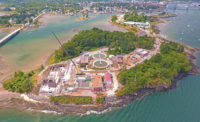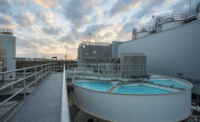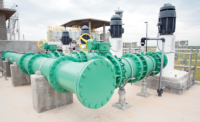Cromwell, Conn.
Key Players
Owner The Mattabassett District
Lead Designer Wright-Pierce
General Contractor C. H. Nickerson & Co.
Structural/Civil/MEP Engineer Wright-Pierce
Electrical Contractor Electrical Energy Systems Corp.
Mechanical Contractor Central Mechanical Services
Originally constructed in the 1960s, the facility underwent an extensive upgrade to comply with Connecticut’s stringent new statewide nitrogen removal requirements, which are designed to improve water quality in the Long Island Sound. A unique configuration of conventional, proven technologies achieved the project’s goals, boosting treatment capacity for the communities served by the treatment plant.
The site was very constrained, so it was not possible to incorporate the new tankage volume needed to accommodate equipment for a conventional biological nitrogen removal system. Using sophisticated computer modeling of the treatment processes, a configuration of the four-stage nitrogen removal system was developed using a “side-stream reactor” that pretreats high-nitrogen content wastewater from the sludge processing operation. The side-stream reactor also promotes the growth of nitrifying bacteria during cold winter conditions due to the warmer temperatures of the recycled wastewater stream.
Other functional and aesthetic features include a new autogenous fluidized bed incinerator that uses little fuel and meets stricter emissions standards. The fluidized bed incinerator is configured to capture and reuse waste energy to heat the building. Modern equipment and controls were also added to achieve substantial power savings, while a new effluent pumping system combined with modifications to the facilities’ outfall diffuser system allows the facility to stay ahead of projected rises in adjacent sea levels.
Existing structures and equipment were rehabilitated and reused where possible. A variety of energy-efficient processes and equipment, control and building systems improvements combined to qualify the facility for more than $1 million in energy rebate grants from the electric utility.
Installation of these features—plus associated upgrades to electrical, HVAC and plumbing systems—were carefully planned and staged to allow the facility to continue treatment operations throughout construction. By preselecting the supplier of the fluidized bed incinerator system, the final design of the new equipment could be finalized while the existing incinerator continued to function until it could be taken off line permanently.
The fluidized bed incinerator and emissions control system have yet to be widely used in the Northeast, so the Mattabassett facility will allow engineers and wastewater treatment system owners to evaluate the technologies’ performance, providing a baseline for future technical requirements.








Post a comment to this article
Report Abusive Comment